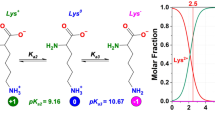Abstract
In this paper we report on the synthesis and solution conformation of a new set of structurally related polycationic branched chain polypeptides (poly[Lys(X i -dl-Ala m )]) with hydrophobic (Ile, Nle, Val) or cationic (Arg) amino acids at the N-terminal end of the side chains as well as their cytotoxic effect on murine bone marrow derived macrophages. Solution conformation of the polypeptides was studied with circular dichroism spectroscopy under different conditions (pH, ionic strength). The results of these comparative studies indicate that a) polypeptides could adopt an ordered (mainly helical) conformation at physiological pH and salt concentration (pH 7.4, 0.2 M NaCl); b) the nature of side chain terminal amino acid (X) could determine under which conditions the ordered structure was formed. Thus, the solution conformation of branched polypeptides could be modulated by the selection of amino acid X under physiological conditions. All polypeptides with hydrophobic amino acid at the terminal position were essentially non-toxic on macrophages, whereas the polypeptide with terminal Arg proved to be markedly cytotoxic.










Similar content being viewed by others
References
Kóczán G, Ghoose AC, Mookerjee A, Hudecz F (2002) Bioconjug Chem 13:518–524
Pang X, Du HL, Zhang HQ, Zhai YJ, Zhai GX (2013) Drug Disc Today 18:1316–1322
Duncan R, Vicent MJ (2013) Adv Drug Deliv Rev 65:60–70
Maeda H, Nakamura H, Fang J (2013) Adv Drug Deliv Rev 65:71–79
Hudecz F (1995) Anti-Cancer Drugs 6:171–193
Böhme D, Krieghoff J, Beck-Sickinger AG (2016) Med Chem 59:3409–3417
Hudecz F, Reményi J, Szabó R, Kóczán G, Mező G, Kovács P, Gaál D (2003) J Mol Recognit 16:288–298
Szabó R, Bánóczi Z, Mező G, Láng O, Kőhidai L, Hudecz F (2010) Biochim Biophys Acta 1798:2209–2216
Votavova H, Hudecz F, Kajtár J, Szekerke M, Sponar J, Blaha K (1980) Coll. Czech. Chem. Commun. 45:941–949
Votavova H, Hudecz F, Sponar J, Szekerke M, Blaha K (1982) Coll. Czech. Chem. Commun. 47:3437–3446
Mező G, Reményi J, Kajtár J, Barna K, Gaál D, Hudecz F (2000) J Control Release 63:81–95
Hudecz F, Pimm MV, Rajnavölgyi É, Mező G, Fabra A, Gaál D, Kovács AL, Horváth A, Szekerke M (1999) Bioconjug Chem 10:781–790
Szabó R, Mező G, Pállinger É, Kovács P, Kőhidai L, Bősze S, Hudecz F (2008) Bioconjug Chem 19:1078–1086
Chen GC, Yang JT (1977) Anal Lett 10:1195–1207
Szabó R, Peiser L, Plüddemann A, Bősze S, Heinsbroek S, Gordon S, Hudecz F (2005) Bioconjug Chem 16:1442–1450
Katchalski E, Grossfeld I, Frankel M (1948) J Am Chem Soc 70(6):2094–2101
Yaron A, Berger A (1963) Biochim Biophys Acta 69:397–399
Bailey JL (1950) J. Chem. Soc.:3461–3466
Kricheldorf HR (1987) Springer-Verlag Berlin Heidelberg pp. 3–58
Chou PY, Fasman GD (1974) Biochemistry 13:211–222
Hudecz F, Szekerke M (1980) Coll Czech Chem Commun 45:933–940
Iwakura Y, Uno K, Kang S (1965) J Org Chem 30(4):1158–1161
Astbury WT, Dalgliesh CE, Darmon E, GBBM S (1948) Nature 162:596–600
Acknowledgments
This work was supported by a grant from the Hungarian National Research Fund (OTKA K104385). R. Szabó (PhD) was supported by the Postdoctoral Fellowship of Hungarian Academy of Sciences (HAS). The authors thank Dr. Zsuzsa Majer for the helpful discussion concerning the interpretation of CD spectra. The authors also thank Dr. Hedvig Medzihradszky-Schweiger for the amino acid analyses.
Author information
Authors and Affiliations
Corresponding author
Additional information
Mónika Sebestyén and Rita Szabó contributed equally to this study.
Rights and permissions
About this article
Cite this article
Sebestyén, M., Szabó, R., Kőhidai, L. et al. Synthesis, conformation and cytotoxicity of new, branched polymeric polypeptides containing hydrophobic amino acid or arginine moiety. Struct Chem 28, 527–535 (2017). https://doi.org/10.1007/s11224-016-0901-z
Received:
Accepted:
Published:
Issue Date:
DOI: https://doi.org/10.1007/s11224-016-0901-z




